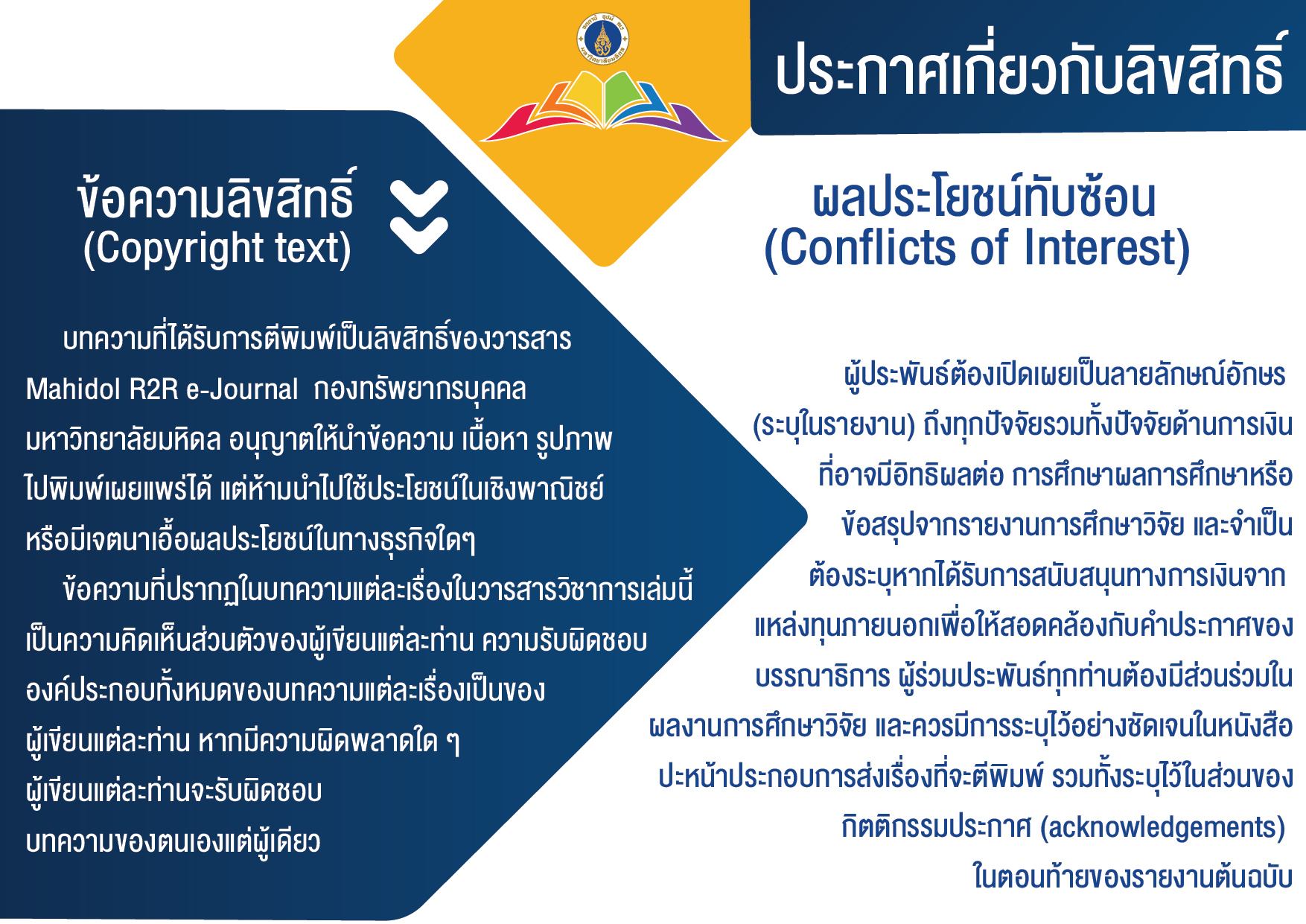คุณภาพการตรวจคริเอทีนินในห้องปฏิบัติการเคมีคลินิกไทย ปี 2564-2565
DOI:
https://doi.org/10.14456/jmu.2024.17คำสำคัญ:
อัตราการกรองของไต, คริเอทีนิน, การประเมินคุณภาพการตรวจวิเคราะห์ของห้องปฏิบัติการโดยองค์กรภายนอก, การทดสอบความชำนาญ, การเปรียบเทียบผลการตรวจวิเคราะห์ระหว่างห้องปฏิบัติการบทคัดย่อ
โรคไตเรื้อรังเป็นปัญหาสาธารณสุขระดับชาติ คนไทยเพียงร้อยละ 1.9 ที่ทราบว่าตนเองเป็นโรคไต การตรวจค้นหาผู้ป่วยและดูแลรักษาผู้ป่วยโรคไตเรื้อรังแต่เริ่มแรก จะช่วยป้องกันหรือชะลอไม่ให้เกิดโรคไตวายระยะสุดท้ายและลดอัตราการเจ็บป่วยหรือเสียชีวิตก่อนวัยอันควรได้ ในการประเมินสภาพการทำงานของไต นิยมใช้การประมาณอัตราการกรองของไต โดยนำค่าคริเอทีนินในน้ำเหลืองและค่าตัวแปรต่าง ๆ ไปคำนวณด้วยสูตร ซึ่งผลการตรวจคริเอทีนินที่ถูกต้อง จะช่วยให้การวินิจฉัยโรคมีประสิทธิภาพยิ่งขึ้น การศึกษานี้เป็นการนำข้อมูลจากผลการรายงานการประเมินคุณภาพการตรวจวิเคราะห์คริเอทีนินของห้องปฏิบัติการเคมีคลินิก ระหว่างปีงบประมาณ พ.ศ.2564-2565 และนำเสนอระดับคุณภาพการตรวจวิเคราะห์ ด้วยคะแนน z-score เพื่อบ่งชี้ระดับคุณภาพและความสามารถในการตรวจคริเอทีนินของห้องปฏิบัติการในประเทศไทย
ผลการศึกษา จากข้อมูลการประเมินคุณภาพการตรวจวิเคราะห์ของห้องปฏิบัติการโดยองค์กรภายนอกหรือการทดสอบความชำนาญ ปีงบประมาณ พ.ศ.2564 จำนวน 772 ห้องปฏิบัติการ และปีงบประมาณ พ.ศ.2565 จำนวน 797 ห้องปฏิบัติการ การศึกษาระดับคุณภาพการตรวจวิเคราะห์คริเอทีนินด้วยกลวิธีการเปรียบเทียบผลการตรวจวิเคราะห์ทางห้องปฏิบัติการทั้งภาครัฐและเอกชนทั่วประเทศไทย พบว่าห้องปฏิบัติการที่มีความสามารถตรวจวิเคราะห์คริเอทีนินถูกต้อง (Accuracy) ด้วยคะแนน Between-laboratories z-score น้อยกว่า 3 ในวัตถุทดสอบที่สารคริเอทีนินความเข้มข้นปกติผ่านเกณฑ์ร้อยละ 96.89 และสารคริเอทีนินความเข้มข้นสูงกว่าปกติผ่านเกณฑ์ร้อยละ 93.48 สำหรับความเที่ยงในการวิเคราะห์ (Precision) ชี้บ่งด้วย Within-laboratories z-score น้อยกว่า 3 ห้องปฏิบัติการวิเคราะห์วัตถุทดสอบสารคริเอทีนินความเข้มข้นปกติผ่านเกณฑ์ร้อยละ 90.28 และสารคริเอทีนินความเข้มข้นสูงกว่าปกติผ่านเกณฑ์ร้อยละ 92.97
ในภาพรวมห้องปฏิบัติการมากกว่าร้อยละ 90 ผ่านเกณฑ์การประเมินคุณภาพการตรวจวิเคราะห์ แต่ห้องปฏิบัติการร้อยละ 3.11 ถึง ร้อยละ 6.52 ที่ผลการตรวจวิเคราะห์คริเอทีนินไม่ผ่านเกณฑ์ในประเด็นความถูกต้องของผลการวิเคราะห์และห้องปฏิบัติการร้อยละ 7.03 ถึง ร้อยละ 9.72 ที่ผลการตรวจวิเคราะห์คริเอทีนินไม่ผ่านเกณฑ์ในประเด็นความเที่ยงของผลการวิเคราะห์ โดยวิธีวิเคราะห์ด้วยหลักการ Jaffe reaction มีจำนวนห้องปฏิบัติการไม่ผ่านเกณฑ์สูงกว่าหลักการอื่นอย่างมีนัยสำคัญ (P<0.05) ดังนั้นจึงมีความจำเป็นที่จะต้องสร้างระบบการควบคุมภายในที่ดีและส่งเสริมการพัฒนาระบบคุณภาพอย่างเร่งด่วน เพื่อให้ระบบการประกันคุณภาพทางห้องปฏิบัติการมีประสิทธิภาพ อันจะเป็นประโยชน์สูงสุดต่อผู้ใช้บริการอย่างแท้จริง
เอกสารอ้างอิง
ประเสริฐ ธนกิจจารุ. (2558). สถานการณ์ปัจจุบันของโรคไตเรื้อรังในประเทศไทย. วารสารกรมการแพทย์, 40(5), 5-17.
สุภาวัลย์ ปิยรัตนวรสกุล. (2564). การประเมินคุณภาพการตรวจวิเคราะห์ห้องปฏิบัติการ เคมีคลินิกไทยโดยองค์กร ภายนอกในช่วงปี 2563-2564. วารสาร Mahidol R2r e-Journal, 8(3), 140-148.
Clinical Laboratory Improvement Amendments of 1988 (CLIA) Proficiency Testing Regulations Related to Analytes and Acceptable Performance. (2019). Federal Register. 84(23), 1536-1567.
Proficiency Testing Australia. (2019, January 1). Guide to proficiency Testing Australia.https://www.pta.asn.au/documents/Guide-to-Proficiency-Testing-Australia.pdf
International Organization for Standardization. (2010). ISO/IEC 17043:2010 (E). Conformity assessment - General requirements for proficiency testing. (1st ed.) ISO copyright office.
International Organization for Standardization. (2012). ISO 15189. Medical laboratories - Requirements for quality and competence. (3rd ed.) ISO copyright office.
International Organization for Standardization. (2015). ISO 13528. Statistical methods for use in proficiency testing by inter-laboratory comparisons. (2nd ed.) ISO copyright office.
International Organization for Standardization. (2016). ISO 13485. Medical devices - Quality management systems requirements for regulatory purposes. (3rd ed.) ISO copyright office.
Levey, AS., & Stevens, LA. (2009). A new Equation to estimate glomerular filtration rate. Annual of Internal Medicine, 150(9), 604-612.
Nigam, PK., & Chandra, A. (2017). Positive and negative false estimates of serumcreatinine. Interventional Cardiology,9(4), 164-165.
Schwartz, GJ., & Haycock, GB. (1976). A simple estimate of glomerular filtration rate in children derived from body length and plasma creatinine. Pediatrics, 58(2), 259-263.
ดาวน์โหลด
เผยแพร่แล้ว
ฉบับ
ประเภทบทความ
สัญญาอนุญาต
ลิขสิทธิ์ (c) 2024 Mahidol R2R e-Journal

อนุญาตภายใต้เงื่อนไข Creative Commons Attribution-NonCommercial-NoDerivatives 4.0 International License.




